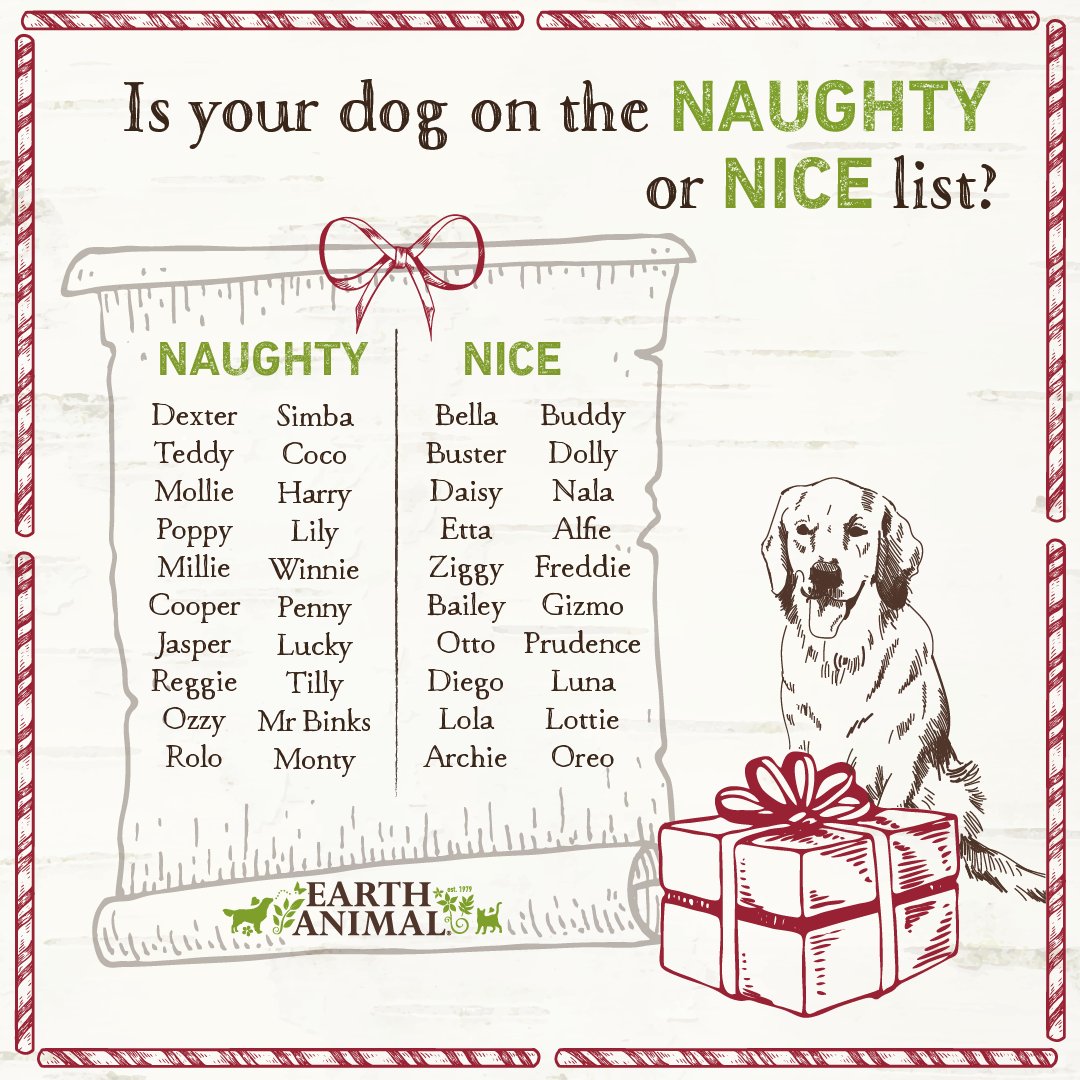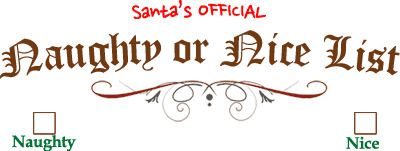To determine if your dog is on the naughty or nice list, observe their behavior. Good dogs typically follow commands and exhibit friendly behavior. So lets read out: Is My Dog on the Naughty or Nice List?
The holiday season brings joy and reflection, even for our furry friends. Many pet owners wonder if their dogs deserve a spot on the nice list. Assessing your dog’s behavior can help you decide. Does your pup follow commands? Are they friendly with family and guests?
Consider their actions over the year. Naughty behaviors, like chewing shoes or barking excessively, may indicate a spot on the naughty list. Conversely, good manners and loyalty often earn them a place among the nice. Understanding your dog’s behavior can deepen your bond and enhance their training. Celebrate their unique personality this holiday season!
Table of Contents
Naughty Or Nice: A Dog’s Tale
Every dog has a story. Some dogs are sweet and loving. Others can be a bit mischievous. This post explores your dog’s behavior. Is your furry friend on the naughty or nice list? Let’s dive in!
Decoding Tail Wags
Tails tell tales. A wagging tail often shows joy. But what do different wags mean?
| Type of Wag | Meaning |
|---|---|
| Fast wagging | Excitement and happiness |
| Slow wagging | Unsure or cautious |
| High wagging | Confident and friendly |
| Low wagging | Submission or nervousness |
Understanding your dog’s tail wag can reveal their mood. A high, fast wag shows happiness. A low, slow wag may suggest fear. Watch closely to decode their feelings.
Barks And Growls: Communication Or Misbehavior?
Dogs use sounds to express themselves. Barks and growls can mean many things.
- Barking for attention
- Growling when feeling threatened
- Barking at strangers
- Whining for comfort
Each sound has a purpose. Pay attention to the context. Is your dog barking at a delivery person? That’s protective behavior. Is it growling during play? That’s excitement.
Understanding these sounds helps determine if your dog is naughty or nice. Positive reinforcement can guide their behavior. Teaching commands and rewarding good actions builds a stronger bond.
Paw Prints On The Carpet: Mischief Or Mistake?
Does your dog leave paw prints everywhere? Are those marks from play or trouble? Understanding your dog’s actions helps you decide if they are naughty or nice.
Dogs can behave in unexpected ways. Sometimes, it’s hard to tell if they are being mischievous or just making a mistake. Let’s explore some common scenarios.
House Training Challenges
House training can be tough for puppies. Accidents happen. Here are some reasons why:
- Age: Young pups may not control their bladders.
- Distraction: Excitement can lead to accidents.
- Health Issues: Conditions like urinary tract infections can cause problems.
To help with house training, follow these tips:
- Take your dog out regularly.
- Reward good behavior with treats.
- Use a consistent command for bathroom time.
When Chewing Becomes Destructive
Chewing is natural for dogs. They explore the world with their mouths. However, chewing can turn into a problem.
Destructive chewing can damage furniture, shoes, and more. Reasons for this behavior include:
- Boredom: Dogs need mental stimulation.
- Anxiety: Stress can lead to chewing.
- Teething: Puppies chew to relieve discomfort.
To prevent destructive chewing, try these strategies:
- Provide chew toys.
- Engage in regular playtime.
- Use positive reinforcement for good behavior.
Understanding your dog’s actions helps you see if they are naughty or just needing guidance.
The Great Escape: Adventure Or Defiance?
Every dog dreams of adventure. Some dogs take their dreams too far. They escape their yard and venture into the wild. Is it a quest for fun or a sign of mischief?
Understanding these escapes helps dog owners decide if their pet is on the naughty or nice list.
Fence Jumping Fiascos
Jumping fences can lead to thrilling adventures. Yet, it often shows defiance. Here are some reasons dogs jump fences:
- Curiosity: Dogs want to explore their surroundings.
- Energy: Bored dogs seek excitement outside.
- Socialization: Dogs may want to meet friends.
Dog owners must understand these motives. This understanding helps correct behavior. Here are tips to keep dogs safe:
- Install higher fences.
- Use fence toppers.
- Provide plenty of exercise.
The Lure Of The Open Door
Every open door is an invitation. Dogs see freedom and adventure. They often dash outside without a second thought. Owners must recognize this behavior.
Here are some common reasons dogs bolt out the door:
- Excitement: A visitor can trigger a quick escape.
- Smells: Interesting scents draw them out.
- Chasing: A squirrel or cat can be too tempting.
To prevent door dashes, try these strategies:
- Train “stay” commands.
- Use baby gates.
- Practice controlled exits.
Digging Up Trouble: Curiosity Or Chaos?
Dogs love to dig. This behavior can be curious or chaotic. Understanding why your dog digs helps determine if they are on the naughty or nice list. Are they exploring their world, or causing mayhem? Let’s dig deeper.
Garden Excavations
Many dogs see gardens as a playground. They often turn beautiful flower beds into digging zones. Here are some reasons why:
- Exploration: Dogs love to explore new scents.
- Play: Digging can be a fun game for them.
- Comfort: Some dogs dig to create a cozy spot.
Garden excavations may seem naughty. However, they often stem from natural instincts. Understanding this helps in managing the behavior.
The Instinct To Burrow
Dogs have a strong instinct to burrow. This behavior can be seen in many breeds. Here’s why they might dig:
| Reason | Description |
|---|---|
| Hunting | Dogs may dig to find small animals. |
| Temperature | They dig to cool off or warm up. |
| Stress Relief | Digging can help relieve anxiety. |
Understanding these instincts can help owners manage digging. Provide alternatives like digging boxes or safe toys. This way, your dog can satisfy their curiosity without creating chaos.
Begging At The Table: Hunger Or Habit?
Does your dog beg at the table? This behavior raises questions. Is it true hunger or just a learned habit? Understanding this can help improve mealtime for everyone.
Understanding Food-seeking Behavior
Dogs are natural scavengers. They often seek food in various ways. Here are some common reasons why dogs beg:
- Hunger: A dog may not have eaten enough.
- Habit: Begging can become a routine over time.
- Social Interaction: Dogs seek attention from their owners.
- Curiosity: Dogs love to explore new smells and tastes.
Recognizing these behaviors helps you understand your dog better. A dog’s begging can be a mix of hunger and habit.
Setting Healthy Boundaries
Establishing boundaries is crucial for good behavior. Here are some tips to help:
- Feed on a Schedule: Regular meals reduce begging.
- Ignore Begging: Do not reward this behavior with food.
- Provide Distractions: Offer toys or treats during meals.
- Train Commands: Teach commands like “sit” or “stay.”
Using these strategies will help your dog understand mealtime etiquette. A calm dog at the table creates a more enjoyable experience.
Canine Companions: Social Butterflies Or Bullies?
Dogs have unique personalities. Some are friendly and social. Others can be a bit more aggressive. Understanding your dog’s behavior helps determine if they are on the naughty or nice list.
Is your dog a social butterfly? Or do they act like a bully? Observing their interactions at the dog park can reveal a lot.
Dog Park Diplomacy
The dog park is a great place for socialization. Dogs meet new friends and learn important skills. Here are some signs your dog is a social butterfly:
- Friendly greetings: Wagging tails and happy barks.
- Playful behavior: Bowing and chasing games.
- Sharing toys: Allowing others to join in play.
On the other hand, some dogs may show signs of bullying. They might not play fair. Watch for these behaviors:
- Stiff body language: Tensed muscles and fixed gaze.
- Excessive barking: Yelling to dominate the situation.
- Interrupting play: Stopping others from having fun.
Signs Of Aggression In Play
Recognizing aggression is crucial. This behavior can ruin fun for everyone. Here are some common signs of aggression during play:
| Behavior | Meaning |
|---|---|
| Growling | Warning or discomfort |
| Snapping | Attempt to bite |
| Chasing others | Trying to dominate |
| Blocking paths | Controlling space |
Monitor your dog’s interactions closely. Early intervention can help. Teach them proper play behavior. A well-socialized dog is a happy dog!
The Jury’s Out: Assessing Your Dog’s Behavior
Is your dog misbehaving or just expressing their personality? Understanding your dog’s behavior helps you determine if they’re on the naughty or nice list. This assessment involves looking at their training, instincts, and overall environment.
The Role Of Training
Training plays a crucial role in shaping your dog’s behavior. Well-trained dogs usually exhibit good manners. Here are some key points to consider:
- Consistency is vital. Use the same commands each time.
- Positive reinforcement works best. Reward good behavior with treats or praise.
- Socialization helps dogs learn how to behave around others.
- Basic commands like “sit” and “stay” are essential for good behavior.
Training sessions should be short and fun. Dogs respond better when they enjoy the process.
Nature Vs. Nurture In Canine Conduct
Your dog’s behavior is influenced by both genetics and environment. Understanding this balance helps you manage their actions. Here’s a breakdown:
| Aspect | Nature (Genetics) | Nurture (Environment) |
|---|---|---|
| Temperament | Some breeds are naturally more energetic. | Training can calm an energetic dog. |
| Social Skills | Some dogs are more predisposed to aggression. | Exposure to different people helps with social skills. |
| Learning Ability | Intelligence varies by breed. | Consistent training improves learning ability. |
Consider these factors while assessing your dog’s behavior. A balanced approach can lead to better understanding and training.

Credit: twitter.com
From Naughty To Nice: Behavior Modification Strategies
Transforming your dog’s behavior requires patience and love. Understanding why your dog misbehaves helps you find the right strategies. Here are effective techniques to guide your furry friend from naughty to nice.
Positive Reinforcement Techniques
Positive reinforcement is a powerful tool. It encourages good behavior through rewards. Here are some effective methods:
- Use Treats: Offer small treats for good behavior.
- Praise: Verbal praise builds your dog’s confidence.
- Playtime: Use play as a reward for following commands.
- Clicker Training: A click sound marks the desired behavior.
Always reward your dog immediately after they display good behavior. This helps them connect the action with the reward.
The Importance Of Consistency In Training
Consistency is key in dog training. Inconsistent rules confuse your dog. Follow these guidelines for success:
- Set Clear Rules: Define what behaviors are acceptable.
- Use the Same Commands: Use consistent words for commands.
- Involve Everyone: Ensure all family members follow the same rules.
- Practice Regularly: Short, frequent training sessions work best.
Being consistent helps your dog learn faster. It builds trust between you and your pet.

Credit: www.northpoletimes.com
Frequently Asked Questions
Is My Dog Naughty Or Nice?
Determining if your dog is naughty or nice involves observing their behavior. Consider their obedience, friendliness, and how they interact with others. A well-behaved dog usually earns a “nice” designation. However, occasional mischief can happen with any pet. Evaluate their actions and adjust your training accordingly.
What Signs Indicate A Naughty Dog?
Naughty dogs often exhibit behaviors like excessive barking, chewing furniture, or ignoring commands. They may also display destructive tendencies when left alone. These signs suggest a need for better training or mental stimulation. Addressing these behaviors early on can help your dog become more disciplined and well-behaved.
How Can I Improve My Dog’s Behavior?
Improving your dog’s behavior requires consistent training and positive reinforcement. Use treats and praise to encourage good actions. Establish a routine that includes exercise and mental challenges. Socialization with other dogs can also help. Patience and persistence are key to fostering a better-behaved pet.
What Activities Keep Dogs Happy And Well-behaved?
Engaging your dog in daily activities keeps them happy and well-behaved. Activities like fetch, agility training, and puzzle toys stimulate their mind and body. Regular walks and socialization with other dogs also contribute to a well-rounded routine. A happy dog is less likely to engage in naughty behavior.
Conclusion
Determining if your dog is on the naughty or nice list can be fun and insightful. Pay attention to their behavior and habits. Remember, every pup has its quirks. Celebrate their good moments and guide them gently through the naughty ones.
After all, every dog deserves love and understanding, regardless of their list status.



